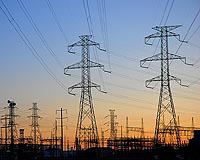 US climate bill would raise energy costs slightly: study
US climate bill would raise energy costs slightly: study

In June, the House passed legislation now before the Senate that aims to reduce greenhouse gas emissions by 17 percent from 2005 levels by 2020, and 83 percent by 2050, create "green" jobs and wean the US economy from oil imports. |
by Staff Writers
Washington Aug 4, 2009
A key climate change bill now being considered by US Congress would only modestly raise annual energy costs for families, far less than some industry estimates, a federal study said Tuesday.
The bill for a typical household's energy costs would increase 83 dollars per year by 2030, or an average of 23 cents per day, according to the estimate by the Energy Department's Energy Information Administration (EIA).
The EIA said the bill "increases energy prices, but effects on electricity and natural gas bills of consumers are substantially mitigated through 2025 by the allocation of free allowances to regulated electricity and natural gas distribution companies."
However, it cautioned that "both wholesale and consumer energy prices rise quickly in the first four years, level off for the next 10 years and then sharply rise for the last five years."
EIA also found that gasoline prices would increase on average by 20 cents per gallon by 2020 and by 35 cents per gallon in 2030. But clean vehicle technology could offset those costs.
"The evidence is now overwhelming that this clean energy legislation is both affordable and effective," Democratic Representatives Henry Waxman and Edward Markey, who co-authored the climate change bill, said in a statement.
"American clean energy will grow substantially, and so will clean energy jobs that can't be shipped overseas."
In June, the House passed legislation now before the Senate that aims to reduce greenhouse gas emissions by 17 percent from 2005 levels by 2020, and 83 percent by 2050, create "green" jobs and wean the US economy from oil imports.
Those levels would be reached through a "cap-and-trade" system that caps pollution levels for large industrial sources but allocates them pollution permits that can be traded.
The report also found that the legislation would accelerate the development and use of clean energy technology, with most of the increases coming in wind generation and biomass generation.
Energy Secretary Steven Chu hailed the report's findings, saying it confirms that "we can move to a clean energy future at a cost of less than a postage stamp per family per day."
The study's findings were consistent with those of the Congressional Budget Office, which projected that implementing the legislation would cost US families 175 dollars per year, and the Environmental Protection Agency, which said it would run at 80 to 111 dollars per year.
But the American Petroleum Institute, a trade group for the oil industry, has said that the bill would cost an average family 3,300 dollars per year by 2020 and cause gas prices to jump 74 percent by 2035.
In another report Tuesday, the Government Accountability Office said that "consumers will bear most of the costs of a cap-and-trade system because most regulated entities will pass along their increased costs in the form of increased prices."
However, it added, "these costs could be largely offset depending on how revenues are used."
Share This Article With Planet Earth
Related Links

 Coal fires up India's farmers against new power plants
Coal fires up India's farmers against new power plants
Poinad, India (AFP) Aug 2, 2009
Rajni Ramakan Patil has a message for the energy companies that want to build coal-based power stations on the land that she and two generations of her family have farmed for more than 50 years. "Even if you give us gold, we won't leave this place. This is our land," she said. Rajni and five other families from the village of Poinad cultivate a small parcel of land on the flat and fertil ... read more
|
 |
|

 Coal fires up India's farmers against new power plants
Coal fires up India's farmers against new power plants